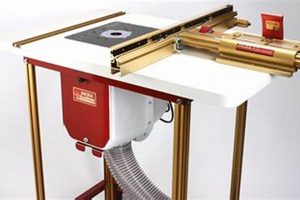A specialized carrier designed to hold and organize implements used in carpentry is an essential accessory for woodworkers. These organizers, typically constructed from durable materials like leather, canvas, or nylon, feature multiple pockets and loops to accommodate various hand tools, measuring devices, and fasteners. An example would be a craftsman using a belt-mounted system to keep chisels, a measuring tape, and screws readily available while working on a complex joinery project.
The importance of such a carrying system lies in its ability to enhance efficiency, safety, and organization within a workshop or job site. By keeping frequently used tools within easy reach, it minimizes wasted time spent searching for misplaced items. This also reduces the risk of accidents caused by loose tools scattered around the workspace. Historically, simpler versions have existed for centuries, evolving from basic leather satchels to the more sophisticated, purpose-built models available today, reflecting the increasing complexity and specialization within the field of woodworking.
Subsequently, the article will delve into the different types available, the materials used in their construction, the key features to consider when selecting one, and tips for maintaining and organizing this crucial piece of equipment.
Essential Usage Considerations
The following guidelines are crucial for maximizing the efficiency and lifespan of the designated storage solution. Adherence to these points ensures optimal tool accessibility, safety, and overall performance during woodworking activities.
Tip 1: Material Compatibility: Ensure the contents carried are compatible with the carrier’s material. Abrasive tools, or those with sharp edges, might prematurely wear down lighter-weight materials. Select accordingly based on the specific tools intended to be stored.
Tip 2: Weight Distribution: Distribute the tools’ weight evenly throughout the various compartments. Uneven distribution can lead to discomfort and potential strain, particularly when the system is worn for extended periods. A balanced load enhances mobility and reduces physical stress.
Tip 3: Regular Cleaning: Periodic removal of sawdust, shavings, and other debris is essential. Accumulated detritus can accelerate wear and tear on both the carrier and the tools stored within. Use a brush or vacuum to maintain cleanliness.
Tip 4: Proper Storage When Not in Use: When not actively in use, store the carrier in a dry, well-ventilated area. Avoid leaving it exposed to extreme temperatures or direct sunlight, as these conditions can degrade the materials. A dedicated storage location prolongs the functional life.
Tip 5: Reinforcement of Stress Points: Regularly inspect for any signs of wear or stress at critical points, such as seams, rivets, and attachment points. Reinforce these areas as needed with appropriate patching or stitching to prevent catastrophic failures.
Tip 6: Secure Fastenings: Routinely verify the integrity of all buckles, straps, and other fastening mechanisms. A compromised fastener can lead to accidental tool spillage and potential injury. Replace any worn or damaged components immediately.
Tip 7: Tool Placement Strategy: Develop a consistent tool placement strategy within the storage solution. Placing frequently used tools in easily accessible locations enhances efficiency and minimizes the time spent searching for specific items.
By adhering to these considerations, the user can optimize the operational effectiveness and longevity of their tool management system, ensuring both safety and productivity. Prioritizing these practices protects the investment and enhances the woodworking experience.
The subsequent sections of this article will build upon these essential practices, offering more in-depth insights into the selection, care, and best uses of these systems.
1. Durability
Durability, in the context of a woodworking tool pouch, directly affects its lifespan and utility. A robust design and quality materials are pivotal, as the pouch is subjected to constant abrasion, weight-bearing stress, and potential exposure to harsh environmental conditions within a workshop or job site. The cause-and-effect relationship is straightforward: substandard materials or construction lead to premature wear and tear, requiring frequent replacements and potentially jeopardizing the safety of the user and their tools. Conversely, durable construction ensures longevity, reducing the overall cost of ownership and providing a reliable storage solution.
The importance of durability is underscored by the nature of woodworking itself. Tasks often involve sharp-edged tools, heavy materials, and physically demanding labor. A pouch prone to ripping, tearing, or losing its structural integrity poses a significant risk. For example, a carpenter working at height relies on a secure and dependable carrier; failure of the pouch could result in dropped tools, causing injury or damage. Therefore, opting for a pouch constructed from heavy-duty canvas, reinforced leather, or high-denier nylon, with sturdy stitching and metal hardware, is not merely a matter of preference but a practical necessity.
In summary, the durability of a woodworking tool pouch directly correlates with its cost-effectiveness, safety, and reliability. The selection of a durable pouch constitutes a prudent investment that yields long-term benefits. Understanding this connection enables woodworkers to make informed purchasing decisions and maintain a well-organized and safe workspace. Failure to prioritize durability can lead to unnecessary expenses, potential hazards, and compromised work quality.
2. Accessibility
Accessibility, within the context of a woodworking tool pouch, denotes the ease and speed with which a woodworker can retrieve specific tools. The efficiency of a workflow is intrinsically linked to the design and organization of the tool-carrying system. Reduced accessibility translates to wasted time, increased frustration, and potentially compromised safety. Optimal accessibility, conversely, enhances productivity and minimizes the risk of accidents.
- Pocket Placement and Design
The strategic placement and design of pockets are critical factors influencing accessibility. Pockets should be sized and positioned to accommodate specific tools comfortably and securely. Open-top pockets provide quick access to frequently used items, while pockets with flaps or closures offer enhanced security for more valuable or delicate tools. A poorly designed pocket layout can lead to tools being difficult to locate or retrieve, hindering workflow efficiency. For instance, a measuring tape placed at the bottom of a deep, narrow pocket necessitates a cumbersome search process, whereas a dedicated, easily accessible clip ensures immediate retrieval.
- Opening and Closure Mechanisms
The method by which a pouch opens and closes directly impacts its accessibility. A pouch with a wide, unobstructed opening allows for easy visual identification and retrieval of tools. Conversely, a pouch with a complicated or restrictive closure mechanism can impede quick access. Magnetic closures, for example, offer a balance of security and ease of access, while zippered closures provide superior protection but may require more time to open and close. The selection of an appropriate closure mechanism should be based on the frequency with which the pouch is accessed and the level of security required.
- Tool Orientation and Retention
The manner in which tools are oriented within the pouch and the mechanisms used to retain them contribute significantly to accessibility. Vertical orientation, for example, allows for easy visual identification of tools, while horizontal orientation may be more suitable for tools with longer handles. Elastic loops, individual sleeves, and magnetic strips can be used to secure tools in place, preventing them from shifting or falling out. An organized system ensures that tools are readily available and eliminates the need to fumble through a disorganized mess.
- Ergonomic Considerations
Accessibility is further enhanced by ergonomic considerations, such as the weight distribution and positioning of the pouch on the body. A well-balanced pouch minimizes strain and fatigue, allowing the woodworker to maintain focus and dexterity. The positioning of the pouch should also be tailored to the individual’s dominant hand and preferred working style. A right-handed woodworker, for example, may prefer to position the pouch on their right side for easy access to frequently used tools. Ergonomic design promotes comfort and efficiency, ultimately improving the woodworker’s overall productivity.
The interconnected nature of these accessibility factors highlights the importance of selecting a woodworking tool pouch that is specifically designed to meet the demands of the task at hand. Neglecting the accessibility aspect can lead to inefficiency, frustration, and potential safety hazards. A well-designed and organized pouch, on the other hand, empowers the woodworker to work with greater precision, speed, and confidence.
3. Organization
Organization, when considering a woodworking tool pouch, transcends mere neatness. It represents a structured approach to tool management that directly impacts efficiency, safety, and the overall quality of workmanship. A well-organized system facilitates rapid tool retrieval, prevents loss or damage, and reduces the risk of workplace accidents.
- Compartmentalization and Tool Categorization
Effective organization necessitates compartmentalization within the pouch. Dividing tools into logical categoriesmeasuring, cutting, fasteningand assigning them dedicated compartments streamlines the search process. For example, storing all screwdrivers together in a designated section eliminates the need to sift through other tools when a specific driver is needed. The result is time saved and reduced frustration.
- Visual Accessibility and Tool Mapping
Organization extends to the visual accessibility of tools. A system that allows for easy identification of tools at a glance is more efficient than one that requires searching. Transparent or color-coded compartments, or tool mappinga mental or physical layout of the pouchcan significantly enhance visual accessibility. A craftsman can quickly assess tool availability and identify missing items, preventing project delays or the use of improper substitutes.
- Tool Security and Retention Systems
A critical aspect of organization is tool security. Pouches with integrated retention systems, such as elastic loops, magnetic strips, or individual sheaths, prevent tools from shifting, falling out, or damaging one another. Secure tool retention not only protects the tools but also safeguards the woodworker from potential injury. A dropped chisel, for instance, can pose a significant hazard in a busy workshop.
- Weight Distribution and Ergonomic Considerations
Organization also plays a role in weight distribution. A well-organized pouch distributes weight evenly across the body, reducing strain and fatigue. Strategic placement of heavier tools closer to the body’s center of gravity minimizes discomfort and promotes better posture. This ergonomic approach not only enhances comfort but also contributes to sustained productivity over longer periods.
The facets of organization outlined above collectively underscore its importance in woodworking tool management. From compartmentalization and visual accessibility to tool security and ergonomic considerations, a well-organized pouch is an invaluable asset for any woodworker. Neglecting the organizational aspect diminishes efficiency, increases risk, and ultimately compromises the quality of work. Conversely, embracing a structured approach to tool management enhances productivity, promotes safety, and contributes to a more enjoyable and fulfilling woodworking experience.
4. Portability
Portability, in the context of woodworking, refers to the ease with which a craftsman can transport essential tools from one location to another. The design and functionality of a woodworking tool pouch directly impact its portability and, consequently, the woodworker’s ability to perform tasks effectively both within a workshop and on remote job sites.
- Weight and Material Composition
The overall weight of the tool pouch, when fully loaded, is a primary determinant of its portability. Heavy materials, while contributing to durability, can significantly increase the burden on the user, especially during prolonged periods of carrying. The composition of the materials used in construction, such as the choice between heavy-duty leather and lightweight nylon, directly influences the weight and, therefore, the portability of the system. A lighter pouch allows for greater freedom of movement and reduces fatigue, enabling the woodworker to maintain efficiency throughout the day. For example, a framing carpenter who needs to move frequently across a construction site would benefit from a lightweight, yet durable, pouch that minimizes strain.
- Carrying Method and Ergonomic Design
The carrying method, whether it be a belt-mounted system, a shoulder strap, or a handle, significantly affects the perceived portability of the tool pouch. An ergonomically designed system distributes weight evenly, reducing pressure points and minimizing strain on the back, shoulders, and hips. A well-designed belt system, for instance, secures the pouch close to the body, preventing excessive swinging and improving balance. Similarly, a padded shoulder strap can alleviate pressure on the shoulder and neck when carrying heavier loads. The choice of carrying method should be tailored to the specific needs of the woodworker and the type of tasks being performed.
- Size and Compactness
The size and compactness of the tool pouch are also crucial factors affecting portability. A bulky or oversized pouch can impede movement and make it difficult to navigate tight spaces. A compact design, on the other hand, allows the woodworker to move freely and efficiently without sacrificing storage capacity. The optimal size of the pouch should be determined by the specific tools that are required for the task at hand. A woodworker performing fine detail work, for example, may only need a small, compact pouch to carry a limited selection of essential tools, whereas a general carpenter may require a larger pouch with greater storage capacity.
- Accessibility During Transport
Portability extends beyond the ability to simply carry the tool pouch from one location to another. It also encompasses the ability to access tools quickly and easily while on the move. A well-designed pouch incorporates features that allow for secure and organized storage of tools, preventing them from shifting or falling out during transport. Quick-release mechanisms and strategically placed pockets enable the woodworker to retrieve tools without having to stop and unpack the entire pouch. This is particularly important for tasks that require frequent tool changes or for situations where the woodworker needs to move quickly between different work areas.
In conclusion, the portability of a woodworking tool pouch is a multifaceted attribute that is influenced by weight, material composition, carrying method, size, compactness, and accessibility during transport. By carefully considering these factors, woodworkers can select a pouch that meets their specific needs and enhances their efficiency, safety, and overall productivity. A portable and well-organized tool pouch is an essential asset for any woodworker who values mobility and convenience.
5. Protection
The safeguarding of implements is a primary function of a woodworking tool pouch. The design and material composition of these carrying devices directly influence the degree to which tools are shielded from environmental factors, impact damage, and loss. The ensuing discussion will detail several facets of this protective function.
- Environmental Shielding
Tool pouches provide a barrier against moisture, dust, and UV exposure, elements that can corrode metal components, degrade wooden handles, and diminish the overall functionality of woodworking tools. A well-constructed pouch, particularly those made from water-resistant or waterproof materials, prevents rust formation and prolongs the lifespan of edged tools. A carpenter working in outdoor conditions, for instance, relies on this protection to maintain the integrity of chisels and saws.
- Impact Mitigation
Tool pouches offer a degree of cushioning against accidental drops or impacts. Padded compartments and robust construction materials absorb and distribute force, reducing the likelihood of damage to delicate measuring instruments, sharp blades, and other sensitive tools. The effectiveness of impact mitigation varies depending on the pouch’s design and the type of materials used. A leather pouch, for example, provides superior impact resistance compared to a lightweight canvas pouch.
- Edge and Tip Security
Woodworking tools often possess sharp edges or pointed tips that pose a hazard both to the tools themselves and to the user. Pouches equipped with individual sheaths, pockets, or straps securely restrain these tools, preventing accidental contact with other objects and minimizing the risk of injury. A dedicated sheath for a carving knife, for instance, protects its delicate tip from damage and prevents it from puncturing the pouch or the user’s clothing.
- Loss Prevention
A well-designed tool pouch aids in preventing the loss of tools, particularly on busy job sites or in cluttered workshops. Designated compartments and retention systems ensure that each tool has a specific place, making it easier to identify missing items and reducing the likelihood of tools being misplaced or forgotten. A carpenter working on a scaffolding, for instance, relies on a secure pouch to prevent tools from falling and potentially causing injury.
These protective aspects of the tool pouch collectively contribute to the longevity, functionality, and safety of woodworking tools. While no pouch can guarantee complete immunity from damage or loss, a thoughtful selection of a pouch with appropriate protective features significantly enhances the woodworker’s ability to maintain a well-equipped and organized toolkit.
6. Capacity
In the context of a woodworking tool pouch, capacity dictates the range of tools a woodworker can efficiently carry, influencing productivity and adaptability. The appropriate capacity depends on the specific tasks and the woodworker’s working style. Selecting a pouch with adequate capacity is a critical decision, balancing the need for a comprehensive toolkit with the ergonomic considerations of weight and size.
- Storage Volume and Tool Quantity
Capacity directly relates to the physical dimensions of the pouch and the number of tools it can accommodate. A larger pouch can hold more tools, enabling a woodworker to tackle a broader range of tasks without returning to a stationary toolbox. For example, a carpenter framing a house might require a pouch with sufficient capacity to hold a hammer, measuring tape, utility knife, nail set, and various fasteners. Conversely, a woodturner focusing on detailed work may require a smaller capacity pouch for a limited set of specialized tools. Overloading a pouch beyond its intended capacity can compromise its structural integrity, hinder accessibility, and create an unsafe working environment.
- Pocket Configuration and Tool Types
The arrangement and size of individual pockets within the pouch influence its practical capacity. A pouch with well-designed pockets, tailored to specific tool types, maximizes space utilization and prevents overcrowding. For instance, a pouch with dedicated slots for chisels ensures they are stored safely and efficiently, while larger pockets can accommodate bulkier items like a block plane or a small square. A poorly configured pouch may have ample overall volume but lack the appropriate pocket sizes and shapes to effectively store the necessary tools, reducing its practical capacity.
- Weight Distribution and Ergonomic Limits
Capacity must be considered in relation to weight distribution and ergonomic limits. A pouch with a high capacity, when fully loaded, can become excessively heavy and uncomfortable, leading to fatigue and potential injuries. The woodworker must balance the desire for a comprehensive toolkit with the need to maintain a manageable weight and comfortable carrying arrangement. Distributing the weight evenly across the pouch and utilizing a well-designed carrying system, such as a padded belt or shoulder strap, can mitigate the strain associated with a high-capacity pouch. However, there is a practical limit to the weight a woodworker can comfortably carry without compromising their efficiency or well-being.
- Task Specificity and Tool Selection
The optimal capacity of a woodworking tool pouch depends on the specific tasks to be performed. A woodworker engaged in general carpentry work may require a pouch with a large capacity to accommodate a wide range of tools. Conversely, a woodworker specializing in a particular skill, such as cabinet making or furniture repair, may only need a pouch with a smaller capacity to carry a select set of specialized tools. Prioritizing the essential tools for a given task and selecting a pouch with an appropriate capacity allows the woodworker to work efficiently without being weighed down by unnecessary equipment.
Ultimately, capacity is a critical parameter in selecting a woodworking tool pouch. The woodworker must carefully assess their tool requirements, task specificity, and ergonomic limitations to choose a pouch that provides the optimal balance of storage volume, organization, and comfort. A well-chosen pouch with an appropriate capacity enhances efficiency, promotes safety, and contributes to a more enjoyable and productive woodworking experience.
7. Ergonomics
Ergonomics, the science of designing equipment and workspaces to fit the worker, is paramount in the context of woodworking tool pouches. Prolonged use of poorly designed systems can lead to musculoskeletal disorders and reduced efficiency. A properly designed tool pouch, adhering to ergonomic principles, mitigates these risks, promoting comfort and enhancing productivity.
- Weight Distribution and Balance
Uneven weight distribution in a tool pouch can place undue stress on specific areas of the body, such as the lower back or hips. An ergonomically sound pouch distributes weight evenly across the body, minimizing strain and promoting better posture. For instance, a belt-mounted pouch with strategically placed pockets for heavier tools ensures balanced weight distribution, reducing the risk of back pain. The implications are reduced fatigue and increased comfort during extended use.
- Accessibility and Tool Placement
The accessibility of tools within the pouch directly impacts the frequency and extent of reaching and bending motions. An ergonomically designed pouch positions frequently used tools within easy reach, minimizing unnecessary strain on the arms, shoulders, and back. For example, a pouch with angled pockets or magnetic holders facilitates quick and effortless tool retrieval, reducing the need for awkward movements. This contributes to a more fluid and efficient workflow.
- Material Selection and Comfort
The materials used in the construction of a tool pouch influence its overall comfort and breathability. Rigid or abrasive materials can cause chafing and discomfort, particularly during prolonged wear. Ergonomically designed pouches utilize soft, breathable materials, such as padded nylon or ventilated leather, to enhance comfort and minimize irritation. The implication is reduced skin abrasion and enhanced user satisfaction.
- Adjustability and Customization
An ergonomically versatile tool pouch offers adjustability to accommodate individual body types and preferences. Adjustable straps, belts, and pocket configurations allow the user to customize the fit and positioning of the pouch, ensuring optimal comfort and support. For instance, a pouch with adjustable lumbar support can alleviate pressure on the lower back. This promotes a personalized and comfortable experience, enhancing both productivity and well-being.
These facets underscore the importance of ergonomics in tool pouch design. By prioritizing weight distribution, accessibility, material selection, and adjustability, manufacturers can create systems that not only hold tools efficiently but also promote the health and well-being of the woodworker. A well-designed, ergonomically sound tool pouch is an investment in both productivity and long-term physical health.
Frequently Asked Questions
The following addresses common inquiries and misconceptions regarding the selection, utilization, and maintenance of woodworking tool-carrying systems.
Question 1: What materials are best suited for a woodworking tool pouch intended for heavy use?
Heavy-duty canvas, reinforced leather, and high-denier nylon are generally considered optimal for tool pouches subjected to rigorous use. These materials offer a balance of durability, abrasion resistance, and weather protection.
Question 2: How does one effectively organize tools within a pouch to maximize efficiency?
Employ a system of categorization based on tool type and frequency of use. Designate specific compartments for measuring tools, cutting tools, and fastening tools. Place frequently used items in easily accessible locations.
Question 3: What are the key ergonomic considerations when selecting a woodworking tool pouch?
Weight distribution, adjustability, and material comfort are paramount. Opt for a pouch that distributes weight evenly, offers adjustable straps for a customized fit, and utilizes breathable materials to minimize discomfort during prolonged wear.
Question 4: How does one properly maintain a woodworking tool pouch to extend its lifespan?
Regular cleaning to remove sawdust and debris is essential. Inspect seams, rivets, and attachment points for wear and tear. Reinforce stress points as needed and store the pouch in a dry, well-ventilated area when not in use.
Question 5: What are the safety implications of using a poorly designed or overloaded tool pouch?
A poorly designed or overloaded pouch can compromise balance, restrict movement, and increase the risk of tool spillage. This can lead to accidents, injuries, and damage to both the tools and the user.
Question 6: How does the size and capacity of a tool pouch affect its overall usability?
The appropriate size and capacity depend on the specific tasks to be performed and the number of tools required. A pouch that is too small may limit tool selection, while a pouch that is too large can be cumbersome and uncomfortable.
The effective use of a woodworking tool pouch necessitates careful consideration of material selection, organization, ergonomics, maintenance, safety, and capacity. Adhering to these principles ensures both efficiency and well-being within the woodworking environment.
The subsequent section will delve into advanced techniques for optimizing tool pouch organization and maximizing its utility.
Conclusion
This exploration has detailed various facets of the woodworking tool pouch, emphasizing its function as an integral component of the woodworking process. Durability, accessibility, organization, portability, protection, capacity, and ergonomics each play a crucial role in determining the effectiveness of such a tool-carrying system. The correct implementation of these factors contributes directly to the efficiency, safety, and overall quality of woodworking tasks.
The ongoing evolution of woodworking techniques and materials will undoubtedly continue to shape the development of this essential accessory. As such, a commitment to informed selection and proper utilization of the woodworking tool pouch remains paramount for all practitioners seeking to optimize their craft and maintain a safe, productive work environment.







